Sierra Nature Notes, Volume 5, May 2005
Local
habitat is related to the broader geographic ranges of plants
Sarah
Kimball , Ph.D. candidate, Department of Ecology
and Evolutionary Biology, University of California, Irvine, CA 92697-2525
Paul
Wilson , Associate Professor, Department of Biology,
California State University, Northridge, CA 91330-8303
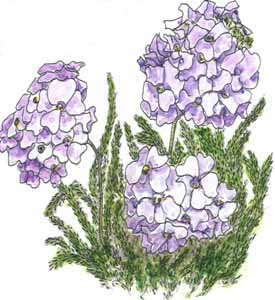 |
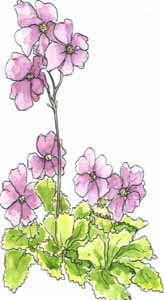 |
Polemonium
eximium (left), also called Sky Pilot, is found at very high
elevations. Another high elevation plant, Primula suffrutescens (right)
has a moderate range size and is found in somewhat moist sites. |
|
Hikers in the Sierra Nevada notice that the plant community changes at different elevations and latitudes. Throughout the montane zone, wet meadows are often filled with shooting stars, monkshood, Sierra lilies, and bog orchids, while paintbrush, cinquefoil, and aster fleabane grow in drier gravelly areas. Mountain sorrel occurs in seeps, and mountain pride covers drier granite boulders with its bright pink flowers. As you walk up the mountain, the plants gradually change, with limber pines replaced by whitebark pines that, on the mountain tops, become windsculpted krumholtz. Those who wander through the alpine zone find mat-forming alpine plants like the alpine penstemon, pussypaws, alpine phlox, and Draba.
Many Sierran hikers have wandered in the Cascades or up to Alsaka as well, and noticed some familiar
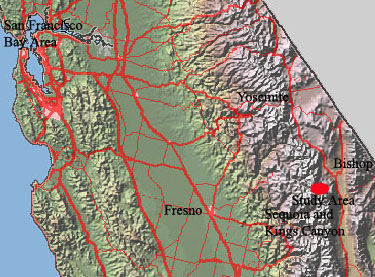 |
species, like bilberry and arctic willow. Other common Sierra plants, such as little elephants heads and alpine sky pilot, are missing, occurring only in the Sierra Nevada. The physiological requirements and tolerances of a species determine both its habitat and its broader geographic distribution. In our research, we therefore predicted that there would be a correlation between the local habitat in which a plant is found and the characteristics of its geographic range. We took this hypothesis as a reason to explore and look at plants in the Bishop Creek watershed on the eastern side of the Sierra.
We hiked throughout the watershed and did our best to identify the plants. This was much easier after we met Jack and Pat Crowther, who have made a list of 872 different types of plants that they have identified in the watershed from the top of Mount Agassiz to the Owens River. Jack, a retired history teacher and basketball coach, has an amazing ability to remember plant names and the characters used to differentiate closely related species. Together with Jack’s help, we were able to identify most species we found. We restricted our study to above 9,000 ft. elevation where we most like hiking. We recorded plants in 263 plots of a 100 m2. Not counting sedges and other such difficulties, we recorded 282 plants. At each plot, we noted the soil wetness, elevation, soil rockiness, and amount of shade. We recorded the exact location with a GPS unit. Wetness, shadiness, and rockiness were estimated on a 4-point scale. For example, rockiness was categorized as (1) well-developed soil, (2) gravel, (3) rock with gravel, or (4) essentially bedrock. Looking up the species in regional floras, we tabulated the size and center of the geographic range of each species.
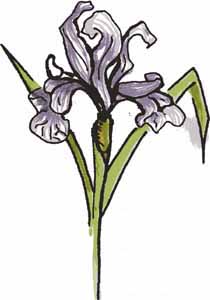 |
| Iris
missouriensis is found in moderately wet meadows and has a huge
range. Illustrations © by Pat Crowther |
In general, the various plants exhibited strong habitat preferences depending on wetness and elevation. Moreover, the habitat preferences within the watershed reflect the broader geographic ranges of the plants. Plants that live in wet places in the Bishop Creek watershed tended to have extremely large ranges centered to the north, up into the Cascades and into the arctic. Plants that live in dry places tended to have much smaller ranges. In some cases, these dry-site plants were endemic to the Sierra Nevada, while others also grew in mountains to the east, like in the White Mountains. Of the plants we found, 58% had ranges extending to Canada, the Rockies, or Mexico, while only 8.3% were endemic.
One possible explanation for the pattern of wet-site plants having large ranges and dry-site plants having small ranges is that wet alpine habitats are well connected to the wet Northwest, while dry alpine habitats are isolated from the mountains to the east by basins of inhospitable desert. Another possibility is that it is difficult for plants to live in dry sites. They must be able to withstand long cold winters and short dry summers. So they tend to have adapted to local conditions and formed distinct species. The wet-site plants in the Sierra Nevada may be good competitors so they are able to range widely. In contrast, the dry-site plants in the Sierra Nevada tend to become specialists to some degree.
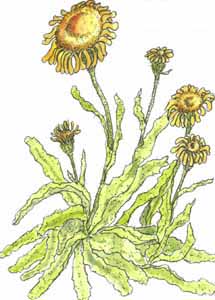 |
Hulsea
algida, or Apline Gold, is another very high elevation plant
of gravelly soils. |
The vast majority of the plants that we studied were only found in other high elevation sites and not in the nearby lowlands. Although this won’t be a surprise to California botanists, it is nevertheless a result so strong that it demands scientific attention. The lowland California flora has almost never spun off populations or neo-species into the alpine zone, nor vice versa. Even the flora of the Owens valley, though it changes gradually as one moves up the mountain, has not exchanged elements with the Sierran flora. Along the crest of the Sierra above Bishop Creek, the flora is more similar to sites hundreds of miles north than 10 miles east or 40 miles west. We conclude that, first, most species are incapable of extreme niche breadth (the seeming exceptions generally being complexes of ecotypes), and second, niche preferences seem to have been very static through evolutionary time.
In summary, the local habitat of the plants observed while hiking through the Sierra reflects the broader geographic range of each species. The abiotic and biotic requirements of each plant do not change as ecological communities have been assembled and reassembled. Finally, the rare endemic plants of the Sierra Nevada are species that tend to occur in dry habitats.
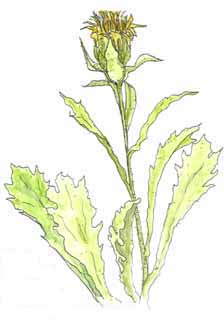 |
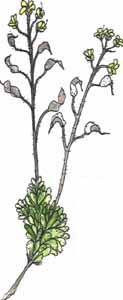 |
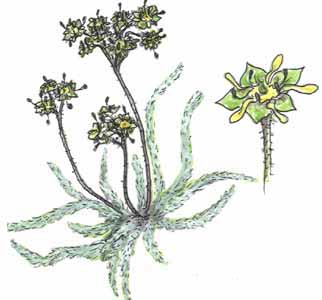 |
| From
left: Tonestus peirsonii is a species of dry outcrops
with a tiny range; Draba lemmonii is a high elevation
species with a small range; and Iveseia muirii is found
in gravelly sites only in the Sierra. Illustrations © by Pat Crowther |
||
Further Reading
Crowther J, Crowther P. 2002. A Bishop Creek checklist, annotated. Pajasz Press, Bishop, CA.
Kimball S, Wilson P, Crowther J. 2004. Local ecology and geographic ranges of plants in the Bishop Creek watershed of the eastern Sierra Nevada, California, USA . Journal of Biogeography 31: 1637-1657. http://grad.bio.uci.edu/ecoevo/skimball/bishop.html
An
Illustrated Flora of Yosemite National Park
By Stephen J. Botti
Illustrated by Walter Sydoriak
Yosemite Association, 2001
A
Sierra Nevada Flora, Norman F. Weeden, Wilderness Press, Berkeley,
Ca 1986 (Third Edition).
Sarah Kimball's Website: http://grad.bio.uci.edu/ecoevo/skimball/
Paul Wilson's Website: www.csun.edu/biology/grad/faculty/wilson.htm
Our Founder Questions? Go to About Our New Site |
Masthead
Photo from: |